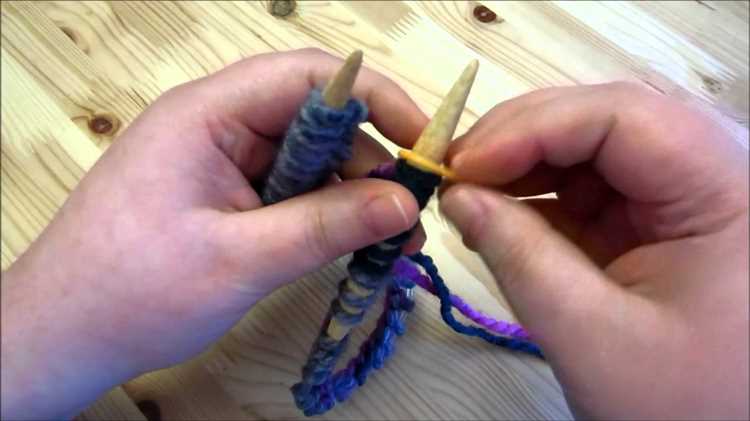Joining in the round is an essential technique in knitting that allows you to create seamless projects such as hats, cowls, and socks. Whether you’re a beginner or an experienced knitter, learning how to join in the round will open up a world of possibilities for your knitting projects.
Step 1: Choose Your Circular Needles
When joining in the round, you’ll need a pair of circular needles. The length of your circular needles will depend on the circumference of your project. For smaller projects like hats, a 16-inch circular needle will work well. For larger projects, like sweaters, you may need a longer circular needle. Make sure to choose needles that are suitable for the weight of yarn you’re using.
Pro tip: If you don’t have circular needles, you can use double-pointed needles or the magic loop method to join in the round.
Step 2: Cast On
Before joining in the round, you’ll need to cast on stitches. The number of stitches will depend on the pattern and the size of your project. Use your preferred cast-on method, such as the long-tail cast-on or the knitted cast-on, to create the foundation row of stitches.
Pro tip: Leave a long tail when casting on to use for seaming later.
Step 3: Join the Round
Once you have cast on your stitches, hold your needle with the working yarn in your right hand and the needle with the unworked stitches in your left hand. Bring the needles together, making sure the cast-on edge is not twisted. Insert the right needle into the first stitch on the left needle from left to right, as if to knit.
Pro tip: Use a stitch marker to mark the beginning of the round. This will help you keep track of your progress and make it easier to count your rounds.
Now that you’ve learned the basic steps to join in the round, you’re ready to start knitting seamless projects. With a little practice, joining in the round will become second nature, and you’ll be able to tackle more complex patterns and designs.
Gather Your Materials
Before you begin joining in the round in knitting, make sure you have all the necessary materials. Here’s a list of what you’ll need:
- Knitting Needles: Choose a set of circular or double-pointed needles in the appropriate size for your project.
- Yarn: Select a yarn that suits your project and matches the recommended gauge.
- Tape Measure: Measure your gauge to ensure your stitches will fit properly.
- Stitch Marker: Use a stitch marker to mark the beginning of each round.
- Tapestry Needle: A tapestry needle will be needed for weaving in ends and finishing touches.
- Scissors: Keep a pair of scissors handy for cutting yarn.
- Pattern: Have a pattern or instructions for the project you’re working on.
Once you have all of these materials gathered, you’ll be ready to start joining in the round and knitting your project with confidence!
Cast On
The first step in joining in the round is to cast on your stitches. There are several methods you can use to cast on, but the most common method for joining in the round is the long tail cast on.
To begin the long tail cast on, you will need a long tail of yarn. This tail will be used to create the first row of stitches. Start by making a slip knot in the yarn, leaving a tail that is about three times the width of your final project.
Once you have your slip knot, place it on one of your knitting needles. Hold the needle with the slip knot in your right hand, and the other needle in your left hand.
Next, insert the tip of the left needle into the slip knot from left to right, making sure to go under the right-hand yarn that is connected to the ball of yarn.
With your right hand, use the tip of the needle to grab the right-hand yarn and pull it through the slip knot, creating a new loop on the left needle.
Continue to insert the left needle into the loop that is now on your right needle, and repeat the process of grabbing the yarn with the right needle and pulling it through to create a new loop. Keep repeating this process until you have cast on the desired number of stitches.
Once you have cast on all of your stitches, you are ready to join in the round by knitting the first stitch of your cast-on row. Place a stitch marker on your right-hand needle to mark the beginning of your round.
Note: Depending on your pattern, you may need to cast on an extra stitch to ensure that your stitches line up correctly when you join in the round.
Arrange Your Needles
Before you start knitting in the round, you will need the following materials:
- A set of double-pointed needles (DPNs) or a circular needle, depending on your pattern and personal preference.
- A stitch marker to mark the beginning of your round.
- A yarn needle to weave in the loose ends when you finish your project.
If you are using DPNs:
- Divide the total number of stitches evenly onto your DPNs. For example, if your pattern calls for 60 stitches, you could distribute them evenly onto 3 DPNs, with 20 stitches on each needle.
- Hold the needles together in your hand, making sure the stitches don’t twist around each other.
- Arrange the stitches so that the first stitch of the round is on the first needle, closest to the tip.
If you are using a circular needle:
- Cast on the required number of stitches onto your circular needle.
- Hold the needle with the cast-on stitches in your right hand, making sure the stitches don’t twist.
- Slide the stitches down the needle so that the first stitch of the round is on the right-hand tip of the needle.
- Place a stitch marker on the right-hand needle to mark the beginning of the round.
Once your needles are arranged and your stitches are divided, you are ready to start knitting in the round!
Join in the Round
Joining in the round is the first step in knitting in the round. It allows you to create seamless tubular knitting, such as hats, socks, and sleeves, without any seams.
To join in the round, follow these steps:
- Cast on the required number of stitches onto your circular needles or double-pointed needles.
- Make sure that your stitches are not twisted. They should all be facing the same way on the needles.
- Slide the stitches to the other end of the needles, so that the working yarn is at the back.
- Hold the needles parallel to each other, with the right needle in your right hand and the left needle in your left hand.
- Take the working yarn (the yarn attached to your ball or skein) and bring it between the two needles, towards the front of your work.
- Insert the right needle into the first stitch on the left needle, from front to back.
- Wrap the working yarn around the right needle, moving it from the back to the front of the work.
- Using the right needle, pull the wrapped yarn through the stitch, creating a new loop on the right needle.
- Slide the stitch from the left needle onto the right needle, leaving the new loop behind.
- Repeat steps 6-9 for all the stitches on the left needle until all the stitches are on the right needle.
Once you have joined in the round, you can continue knitting in a spiral, without turning your work, until you have completed your project.
Knit the First Round
Now that you have joined in the round, you are ready to start knitting the first round. Follow these steps:
- Hold the knitting needles with the cast-on stitches in your left hand.
- Insert the right needle into the first stitch on the left needle, going from left to right.
- Wrap the working yarn around the right needle in a counter-clockwise direction.
- Pull the right needle through the stitch, bringing the new loop of yarn through the old stitch.
- Transfer the new stitch from the right needle to the left needle.
- Repeat steps 2-5 for each stitch on the left needle, knitting all the stitches.
Continue knitting in the round, following the same steps for each round until your project is complete. Make sure to keep track of the number of rounds you have knit if your pattern calls for a specific number.
Happy knitting!
Continue Knitting
Once you have successfully joined in the round, you can continue knitting your project in the desired stitch pattern. Here are some steps to help you continue knitting:
- Avoid Twisting: Make sure that your cast-on edge is not twisted when you join in the round. Check that all the stitches are facing the same way before starting to knit.
- Identify the Beginning of the Round: As you continue knitting, it can be helpful to mark the beginning of the round with a stitch marker or a piece of contrasting yarn. This will make it easier to keep track of your progress and any stitch pattern repeats.
- Work the Stitches: Continue working the stitches in your chosen stitch pattern. Follow the instructions for your specific project, such as knitting in the round in stockinette stitch, ribbing, or any other desired pattern.
- Count your Rounds: It’s a good idea to keep track of the number of rounds you’ve worked, especially if your pattern requires a specific number of rounds or if you want to ensure symmetry in your project.
- Beware of Tension: When knitting in the round, it’s important to be mindful of your tension. Make sure your stitches are neither too tight nor too loose to ensure an even and consistent fabric.
- Repeat as Necessary: If your project requires multiple rounds of the same stitch pattern or if you’re working a larger project, you will need to repeat the instructions for each round until you reach the desired length.
Remember to consult your specific project instructions and take breaks as needed. Happy knitting!
Check Your Work
Once you have completed the steps to join in the round, it’s important to check your work to make sure everything is correct. Here are a few things you should do:
- Count your stitches: After joining in the round, count the number of stitches on your needles. This will ensure that you haven’t accidentally added or dropped any stitches during the process. The number of stitches should match the pattern or project instructions.
- Check for any twists: Take a close look at your work to make sure there are no twists in the knitting. If you notice any twists, you will need to undo the joining and start again. Knitting in the round requires all stitches to be oriented in the same direction.
- Inspect the join: Examine the join itself to ensure that it is smooth and even. If there are any gaps or loose stitches, you may need to adjust your tension or technique. A neat and secure join will result in a more polished finished piece.
- Review the pattern: Take a moment to review the pattern or project instructions to make sure you are following the correct steps. Double-check any special techniques or stitch patterns that are involved in the round knitting. It’s always better to catch any mistakes early on.
By checking your work at this stage, you can avoid potential problems and ensure that your knitting in the round is off to a good start. Once you are satisfied with your work, you can continue knitting in the round according to the pattern or project instructions.
Finish Your Project
Once you have completed your project in the round, it’s time to finish it off and secure the stitches so they don’t unravel. Here are a few steps you can follow to finish your knitting project:
- Weave in the ends: Take a tapestry needle and thread it with one of the loose ends of yarn. Insert the needle into the back of the nearby stitches, then weave it in and out of the stitches for about an inch. Repeat this process with the other loose end of yarn, making sure to weave in all loose ends securely.
- Block your project (optional): If you want your project to have a more finished and polished look, you can block it. Blocking involves wetting your knitted item, then shaping and pinning it into the desired dimensions. Allow it to dry completely before unpinning.
- Remove your knitting from the needles: Carefully slide the stitches off the circular needles, making sure not to drop any stitches. You can transfer them to a stitch holder or to a spare needle if you plan to continue knitting.
- Secure the last stitch: On the last stitch of your project, cut the yarn, leaving a tail of about 6 inches. Thread the tail through the tapestry needle, then pass the needle through the last stitch. Pull tight to secure the stitch.
- Finishing touches: Depending on the project, you may want to add any desired embellishments, such as buttons or pompoms. Sew them securely onto your finished knitting.
With these steps, you can successfully finish your knitting project in the round. Take a moment to admire your handiwork and enjoy the satisfaction of completing a beautiful garment or accessory!
FAQ:
What does it mean to join in the round in knitting?
To join in the round in knitting means to connect the ends of your knitting, creating a continuous loop to work in a circular shape without a seam.
Why is joining in the round important?
Joining in the round allows you to knit seamless items such as hats, socks, and cowls. It eliminates the need to sew a seam after knitting and creates a more professional-looking finished product.
What materials do I need to join in the round?
To join in the round, you will need circular knitting needles or double-pointed needles, depending on the size of your project. You will also need yarn and any additional materials required for the specific pattern you are following.


